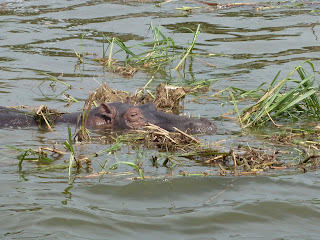The end of the week was really much more fun. On Thursday morning I travelled south to Queen Elizabeth National Park. On the journey we crossed the equator and I was in the southern hemisphere for the first time. On Thursday afternoon I took a boat ride on the Kazinga Channel that runs between Lake George and Lake Edward. I saw an amazing number of hippos! I also saw elephants, Nile crocodiles, water buffalo, Uganda kob, a Nile monitor lizard and birds of just about every shape and size.
I spent the night at the Bush Lodge that is right on the Kazinga Channel. It was composed of permanent tents on stilts and was a nice place stay, although I didn't get much sleep, all the hippos and wart hogs surrounding the area were just too loud!
On Friday we left before sunrise and made our way to the Kasenyi Plains to drive the wildlife trails. We had a very fruitful morning spotting, kob, elephants, water buffalo, water bucks, a spotted hyena and a lion laying on top of a termite mound! We were very lucky to see a lion at all. My driver had spoken to many other guides that were frustrated they couldn't find any for their customers.
In the afternoon we drove down to Ishasha where there are rare tree-climbing lions. The road down is only 70 km but it took us over three hours because the condition of the road was so bad. During the trip we came upon an elephant at the side of the road. We stopped, turned the car off and waited quite a while for it to cross, but it wouldn't move. Finally, my driver asked if I thought we could drive by, and I said yes, as along as we go slow. I now know better. As soon as we were about opposite the elephant on the road, it got scared and started to charge at us. Fortunately my driver had the presence of mind to floor it and we escaped unscathed.
I stayed the night at the Savannah Resort Hotel, which was extremely nice, but not too expensive. The next morning, we left again before sunrise and returned to Ishasha with hope that the fires had burned out. This was the case and we were able to see a completely changed landscape as well as another spotted hyena, herds of kob, water buffalo, and topi and numerous birds.
We drove around the roads and around known lion trees for 3 hours, but saw no lions and decided to head back north. On the way back up the terrible 70 km road, we finally found the tree climbing lions we had been looking for in Ishasha. The picture is not great because of the distance, but trust me, there are three lions in this tree. I had a much better view through my binoculars.
We finished the trip with a visit to some of the explosion craters along Crater Drive back in the north end of the park. It was a spectacular trip and I wish I could have spent more time exploring.
I'm off to Kampala on Tuesday and I can't believe how quickly time has passed. I am looking forward to the indoor plumbing at home, but will miss the people here when I leave.



























